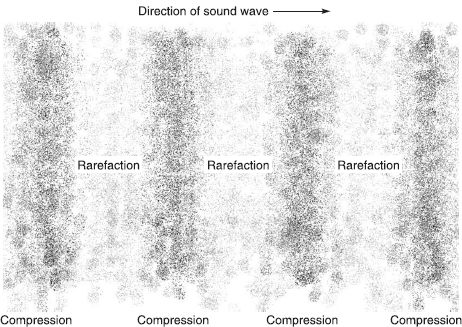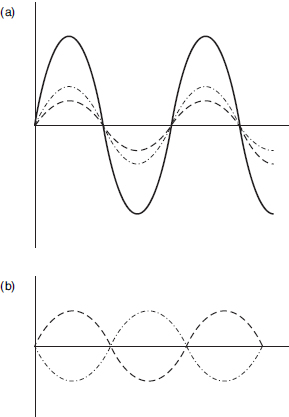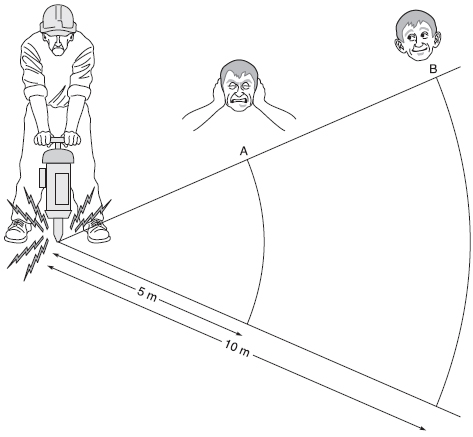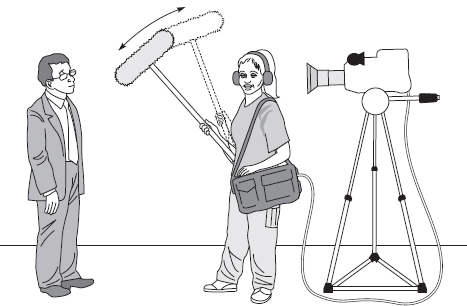Although you're familiar by now with elastic bands (and plastic ducks!), you may not be quite so familiar with the terminology and figures used when measuring sound. Be aware though, that, as mentioned at the end of the previous section, with regard to human hearing, all figures given are approximate, since the absolutes vary from person to person, and hearing normally deteriorates with age and with any continued exposure to high sound levels (see Section 16, Safety). The human ear is sensitive to changes in loudness (level) but is more sensitive to changes in level within a specific range of frequencies – those covered by the voice.
Frequency
Hertz – Hz, is the SI unit representing the frequency of sound in cycles per second. In the same way that ‘normal’ human vision is termed 20/20, I like to think of ‘normal’ human hearing as being approximately ‘20/20’, but that's 20 Hz to 20 kHz. The approximate range of human speech is about 75 Hz to 4 kHz (but there are also harmonics above these frequencies, depending on voice timbre).

Figure 2.1 Compression and rarefaction of air molecules, sound travels at approximately 340 metres per second through the air
The higher the frequency, the shorter the wavelength of the sound. Without getting too technical, there's a mathematical relationship between frequency, wavelength and velocity:
velocity = frequency × wavelength
Hey, that's not complicated, you say. Ah yes, but … the speed of sound in air – the main way we hear sound – depends on air temperature and pressure, and the presence of other particles in the air (humidity, pollution, etc.). It's usually quoted as being approximately 340 metres per second, and that's in still air. Additionally, you must expect air currents, wind, convection, etc. in normal surroundings, so you will appreciate how difficult it is to give meaningful figures for practical recording purposes – you can often hear sound ‘carried on the wind’ for considerable distances in the open air. The actual speed of sound in air doesn't alter, but the particles of air that transmit the sound energy are themselves moving, and essentially transporting the result over a greater distance in the direction the wind is blowing.
Doppler effect
However, if either the source, or the listener, begins to move, you become aware of the Doppler effect, a perceived alteration of the frequency. If the distance between source and listener is decreasing, the frequency is raised, and vice versa. Stand beside a busy road, with traffic moving at speed, and the effect is easily appreciated – ‘Wheeeeoooow’ – as we used to yell as kids. (See also Moving mics, below.)
Sound reflection and absorption
But in the normal course of events, you'd be forgiven for thinking that the speed of sound wouldn't unduly affect your work, especially using a mic relatively close to the sound source. However, although the direct sound may remain unaffected, indirect, or reflected sound, can easily add unwanted or unexpected colouration to the end result.
Depending on your environment, sound may be reflected or absorbed by the material covering objects/furniture/surfaces in your surroundings. And different wavelengths behave in different ways, for instance, wavelengths longer than the dimensions of an object tend to ‘bend’ around it, and may not be significantly impeded in their passage, whereas shorter wavelengths are more likely to be reflected and/or absorbed (see also Acoustics, below).
Thus it is perfectly possible for a sound from a particular source to appear clear or muddied or sharper or flatter than its ‘true’ or ‘close-up’ value as perceived by the ear (or mic) as you move around a location. This alteration in the precise nature of the perceived sound at a particular spot is what is meant when we use the term ‘colouration’, and care must be exercised in the placement of mics to avoid distorting effects produced in this way, especially if they sound unpleasant or unnatural (see also Moving Mics below).
Sound waves interact with each other when their wavelengths are the same, or as near as makes no difference, and this is mostly how colouration is produced. If the crests/peaks coincide, they add to each other, thus increasing their intensity (and, therefore, sounding louder) at that point in space, and they are said to be ‘in phase’. If, on the other hand, they cancel each other out, you will be unable to hear any evidence of that frequency at that point, and they are said to be ‘out of phase’ (Figure 2.2(a),(b)). (A similar visible effect occurs when wave crests are reflected off a harbour wall, for example, and interact with oncoming waves, most noticeable where the cumulative effect is observed.)
Phase difference may be expressed in terms of degrees, thus 180° is out of phase (complete cancellation of waves), and 0° and 360° are in phase (cumulative waves). Phase differences outside these absolutes lend colouration to sound, either by adding to or subtracting from the intensity at a given frequency.

Figure 2.2 (a) Combining signals in graphical form from sound waves in phase increases intensity; (b) combining signals in graphical form from sound waves out of phase cancels the output
Phase difference is utilized in directional microphones, designed in such a way that sounds off axis tend towards cancellation. The success of any individual design is dependent on the physical size/length of the mic housing, and the size/distribution of ‘ports’ along its barrel (interference tube), limiting its range of frequency cancellation.
Moving mics
Phase problems are not necessarily limited to sound reflections, and can occur when using more than one mic. Should you move one of them relative to a fixed (static) sound source, or the source (e.g. person) moves relative to the mics, you will almost certainly find a phase difference between the sounds arriving at each mic. This is because a varying time differential has been introduced to the sound arriving at each mic, leading to some frequencies being enhanced and others attenuated (an effect known as comb filtering). The effect is at its most apparent, and unpleasant, when the speed of the mic, or source, keeps changing, continuously altering which frequencies are affected.
Thinking aloud
When measuring sound intensity we use a unit called the decibel, dB. It is a measurement of the relationship of one intensity to another, in other words, one sound is ‘x’ number of units (dBs) louder or quieter than another. It is based on a logarithmic scale, since this matches the way the ear responds to intensity.
But, in the world of sound, this unit has the potential for great misunderstanding. That is because it depends on which side of the mic capsule you take the measurement. On the real world, noisy side, you are measuring pressure differences/intensities, which activate the capsule, whilst on the signal side, you are measuring a varying voltage produced by the capsule. Would that the scientific fraternity had decided to appoint differing units to these measurements, but they opted for the dB in both cases.
Beware! Measurements relating to sound pressure/intensity produce an increase of 3 dB for a doubling in intensity; whereas with voltage (signal strength), a doubling produces an increase of 6 dB.
Since the measurements we use in recording, pertaining to our meters, are on the signal side of the mic, we are solely concerned with voltage variation, and so dB values quoted in the text assume that a rise of 6 dB indicates an increase in sound level by a factor of 2. This equates with the vision signal, where an increase of 6 dB indicates the equivalent to opening up one stop (a doubling of light level).
Inverse square law
Having mentioned a doubling of light, you're probably also aware of how its intensity falls off in relation to its distance from the source. The same law applies equally to sound. In still air, the energy of a sound wave is dissipated by the square of its distance from the original source (technically, this should be a ‘point’ source) (Figure 2.3). This means there are greater differences in level (dBs) close to a sound source of varying intensity than from a distance from that source. Thus, if a mic is positioned too close to someone's mouth, a clip mic on the neck of a T-shirt for example, the sound level is extremely sensitive to head movement. On the other hand, you can take advantage of the effect when operating a gun mic on a pole, by altering its distance from the speaker's mouth to accommodate the changes in voice level (Figure 2.4).
Acoustics
With an awareness and understanding of the technical considerations outlined above, we can apply this knowledge to the way we approach our operation in the ‘real’ world, and can begin to appreciate how we may best undertake our sound recording. For example, when we're working indoors, the dimensions of the location, and the fabrics on furniture and fittings, can influence the way sound is reflected (and absorbed), and this almost certainly ‘colours’ the overall sound arriving at the mic. Hard surfaces reflect sound (the bathroom effect!) and large concert halls are usually designed to have a long sound decay (reverberation).

Figure 2.3 Inverse square law. The intensity of sound at point B is one quarter that of the intensity at point A

Figure 2.4 Vary the position of the mic to accommodate the changes in voice level
Therefore, if you're working in such a way that some colouration is unavoidable, as long as the camera is positioned to show the nature of the location, then the viewer accepts, for example, that a bathroom will echo more than a living room.
Intelligibility
However, to ensure the intelligibility of your sound, it's best to opt for a location that's as acoustically ‘dead’ as possible. Given the choice, pick a room with absorbent materials such as thick curtains and carpets and well-upholstered furniture. Avoid large flat surfaces, for example, bare walls, wood panelling, windows, glass-fronted cases, plain tables, etc. and don't work ‘into’ the corner of a room.
Carry some sound-deadening material/s with you, heavy drapes are useful, but may prove unwieldy for large areas. Caution: take care when gaffer taping or tying (or anything else!) to fixtures and fittings to stabilize them, they're unwieldy and have minds of their own. Wherever you are, always take care that you have enough room in which to work, especially if you're adding to surrounding clutter, and make sure you don't accidentally knock over valuable objets d'art! (see also Section 39, Insurance).
